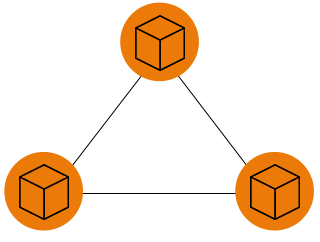S3 object storage is a solution for securely and reliably storing large volumes of data and providing easy access to them.
Different ways of storing data
There are three types of storage options. Below we explain each one in detail.
File storage

It is similar to the physical organization of documents in folders. In this case, data is stored as a single piece of information inside an electronic folder. When you need to access this fragment, the computer should know the path to find it. Data stored in files are organized and retrieved using a limited amount of metadata that tells the computer exactly where the file is stored.
To understand, you can imagine a filing cabinet. Each document is arranged in some logical hierarchy – a cabinet, a drawer, a folder, and then the piece of paper itself with the information.
This is the oldest and most widely used storage system for direct and network-attached storage. You have probably used one yourself. Every time you access documents stored in files on your computer you use file storage. It is very flexible and can store anything. It is good for storing an array of complex files and allows you to navigate through them quickly.
The disadvantage of this method is that a virtual filing cabinet can be accessed within a certain limit. File systems should only scale by adding new systems and not by increasing capacity.
Block storage

The idea behind block storage is that the data there is broken down into blocks, and stored separately. Each block is given a unique identifier, enabling the storage system to allocate smaller fragments of data whenever it is more convenient. In other words, some data may be stored in a Linux environment, and others in a Windows environment.
Block storage systems are often configured so that data is separated from the user environment and distributed across multiple environments that can better serve the data. Then, when information is requested, the underlying software reassembles the blocks from these environments and provides them to the user.
Since block storage does not depend on a single path to the data, as with file storage, information can be retrieved more quickly. Each block exists independently and can be partitioned to be accessed in another operating system. This provides the user with complete freedom of customization. The method is reliable and easy to use and manage. It works well for businesses that carry out large transactions, or deploy huge databases.
The main disadvantage of block storage is its high cost. Also, it offers limited metadata processing capabilities. They need to be handled at the application or database level, adding another entity for the developer or system administrator to worry about.
Object storage

Object storage is a flat structure where files are partitioned and distributed across hardware. These parts are called objects and are stored in a single repository, rather than as files in folders or blocks on servers.
Object storage volumes work as modular units: each one is a separate repository holding data, a unique identifier that allows the object to be found in the distributed system, and metadata describing the data.
These include age, confidentiality/security, and access contingencies. Object metadata can be very detailed and store information such as where a video was taken, which camera was used to take the photo, etc. The operating system uses metadata and identifiers to retrieve the data, allowing for better workload distribution and making it easier for administrators to apply policies for reliable retrieval.
Object storage requires a simple HTTP application programming interface (API). Object storage is cost-effective: you only pay for what you use. It is easily scalable, so it is well-suited as a public repository. The system works well with static data, and because it is flexible and flat it can scale up to really high volumes. The objects contain enough information for the application to find the data quickly, as well as good for storing unstructured data.
The disadvantage is that objects cannot be modified, you have to completely write the object. Object storage also works poorly with traditional databases because writing objects is a slow process and it is more difficult to write an application to use the object storage API than for file storage.
Benefits of object storage
So why is S3 object storage better for business?
-
Low cost. The customer usually only pays for the capacity and time actually used.
-
Excellent scalability. It can easily be scaled up or down to meet needs. Moreover, automatic scalability is also possible.
-
Reliability. The risk of data loss is minimal.
-
High availability. You get access to your information at any time, from any device, anywhere in the world.
-
Security. Data is encrypted, and access to information is restricted to a limited group of people.
-
Easy to manage. User-friendly interface for working with information.
Cloud4Y object storage
Cloud4Y offers a solution for storing backups, documents, and archive data, as well as content distribution with reduced load on core capacities. The guaranteed level of data reliability and availability is 99.99999999999%.
We don't charge for incoming traffic, and storage capacity can be scaled up without any restrictions.



